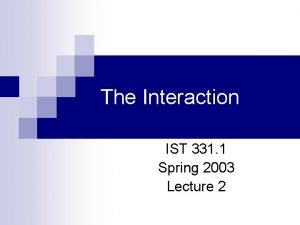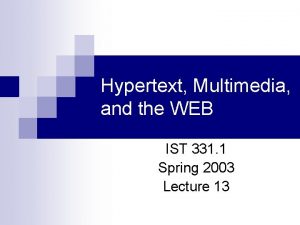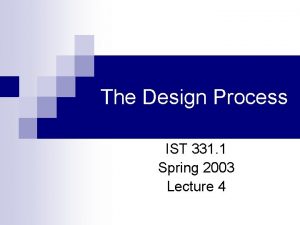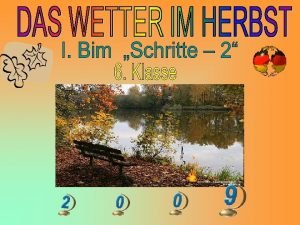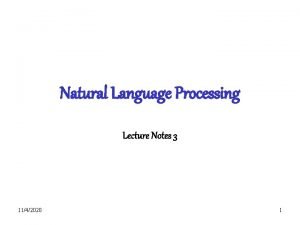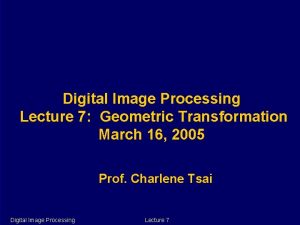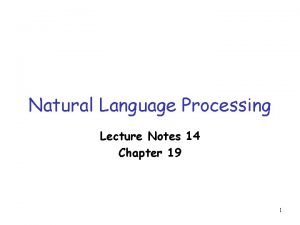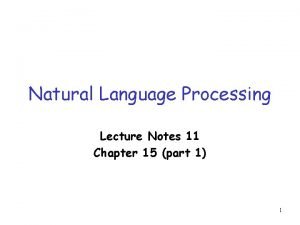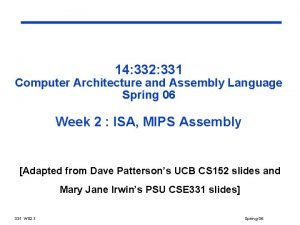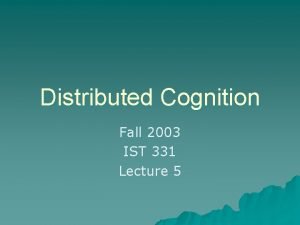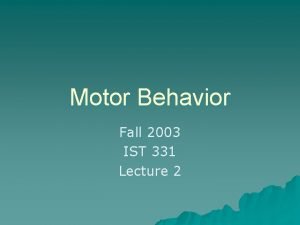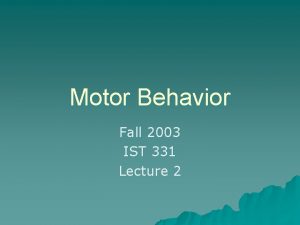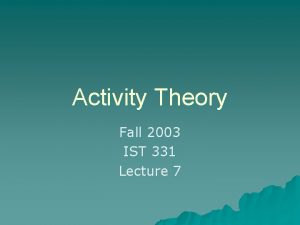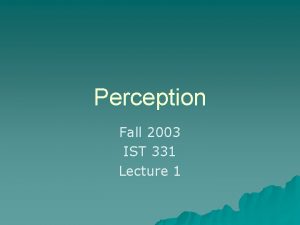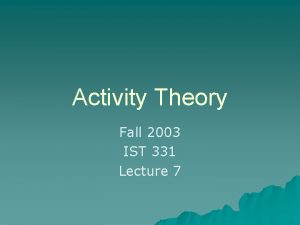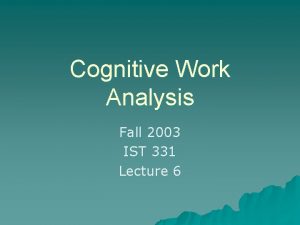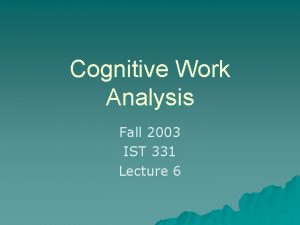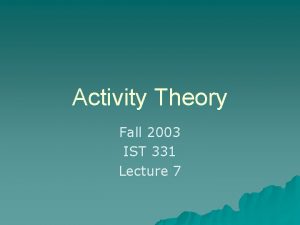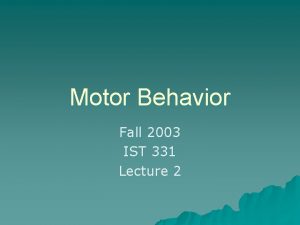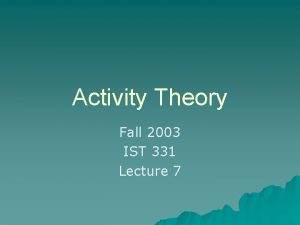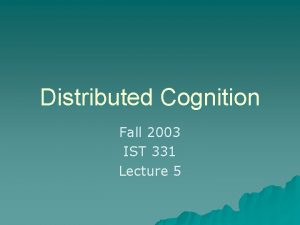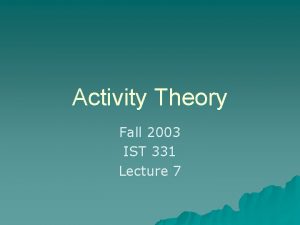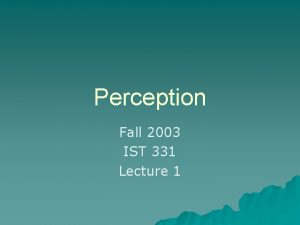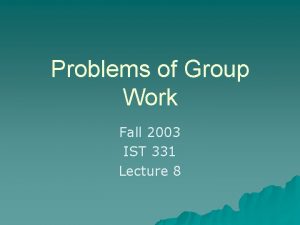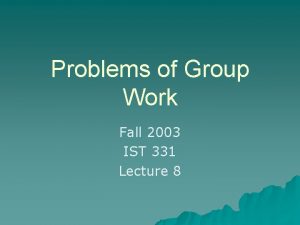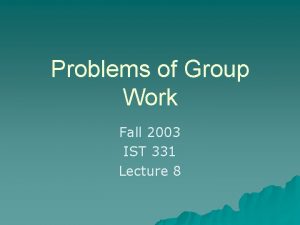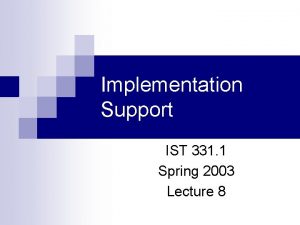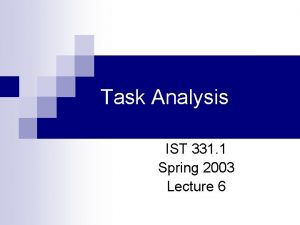Information Processing Fall 2003 IST 331 Lecture 3





















- Slides: 21

Information Processing Fall 2003 IST 331 Lecture 3

Human Performance u Enhanced through use of machines u Consider interface connecting human and machine u Success of system depends on the design of the interface

Human Performance u Apply human information processing (HIP) to design of computer interfaces resulted in philosophy composed of: – Task analysis – Approximation – Calculation

Human Performance u Card, Moran, and Newell – Concentrated on common situation of skilled users performing tasks within their area of skill – Approximating actual performance by error-free performance – Produced models called GOMS u Goals u Operators u Methods u Selection rules

Models u. A model is a simplification of reality u Useful to help design, evaluate or understand complex behavior such as interaction with a computer system u Think of models on a continuum – Analogy and metaphor at one end – Mathematical equations at the other end

Predictive Models u Allow measurement of human performance in an analytical method – No need for time-consuming experiments – Allow a hypothetical design scenario without implementing a real system

GOMS The fox jumps over the lazy quick brown dog.

GOMS u GOMS is a method for describing a task and the user’s knowledge of how to perform the task – Goals – the user’s goals; what does he/she want to accomplish? – Operators – actions that the software allows the user to take u Could be a command u Menu selection u Button press u Most common operators for analysis are at the “keystroke level” such as moving the cursor, clicking mouse button keying information

GOMS – Methods – well-learned sequences of subgoals and operators that can accomplish a goal – Example: 1. 2. 3. 4. 5. Highlight the text to be moved Type CTRL-X Move the cursor to the desired location Click the mouse button Type CTRL-V – If there is more than one method to accomplish the same goal, then selection rules are required

GOMS – Selection rules – personal rules that users follow in deciding what method to use in a particular circumstance u GOMS analysis applies to situations when users perform tasks they have mastered - Cognitive Skill. u Users are not problem solving!

GOMS u Has been applied to: – Text editors – Spreadsheets – Information browsers – Operating systems – Flight-management computers in commercial airplanes – Etc.

GOMS Quantitatively – good predictions of performance time and relative learning time u Qualitatively – used to design training programs, help systems, and actual systems u When GOMS uncovers a frequent goal supported by a very inefficient method, the design can be changed to be more efficient u

GOMS Case Study u Project Ernestine – 1988, NYNEX, telephone company considered replacing workstations – Toll and assistance operators (TOA) – Factor driving decision making was improved productivity of TOAs – Decrease of 1 second in work time per call would save ~ $3 million per year

GOMS Case Study u GOMS modeling took 2 personmonths using CPM_GOMS technique – Quantitative predictions, using expert call-handling time as benchmark – New workstations would be an average of 0. 63 seconds slower than the old workstations – NYNEX would need an additional $2 million a year to operate

GOMS Case Study u Field Trials – Took 18 months involving scores of people – Supported CPM-GOMS predications – New workstations were 0. 65 seconds slower on average than the old workstations

GOMS Case Study u GOMS models helped explain why the new workstations were slower – CPM-GOMS based on critical path of a task – Whole task, the faster features of the new workstations failed to shorten the critical path to complete each TAOs task

GOMS u Three critical restrictions on kinds of tasks GOMS models can be used for 1. Task in question must be analyzed in terms of “how-to-do-it” or procedural knowledge required 2. GOMS analysis can represent only skilled behavior 3. The designer must start with a list of toplevel tasks or user goals u u u Comes from interviews with potential users, Observations of users of similar systems Intuitions of the analyst

GOMS u The strength of GOMS is in its quantitative predictions of performance time and qualitative explanations for those predictions

Keystroke-Level Model u KLM – Prediction is the sum of times and overhead – Four motor-control operators u. K = key stroking u P = pointing u H = homing u D = drawing – One mental operator u. M – One system-response operator u. R

CMN-GOMS u GOMS model presented by Card, Moran, and Newell u Strict goal hierarchy u Operators are executed in strict sequential order u Methods are represented in pseudocode-like notation

Problem Each group form 2 sub-groups u One group study KLM, the other study CMN-GOMS u Each sub-group apply their method to the following problem u – In an Excel spreadsheet, enter 2 numbers into cells then compute the sum of the numbers in an adjacent cell u Share your method with the other part of your team
 Ist 331
Ist 331 Ist 331
Ist 331 Ist spring design
Ist spring design Cast of spring, summer, fall, winter... and spring
Cast of spring, summer, fall, winter... and spring 01:640:244 lecture notes - lecture 15: plat, idah, farad
01:640:244 lecture notes - lecture 15: plat, idah, farad Es ist kalt es ist kalt flocken fallen nieder
Es ist kalt es ist kalt flocken fallen nieder Meine lieblingsjahreszeit ist der winter
Meine lieblingsjahreszeit ist der winter Klassendienst
Klassendienst Es ist herbst es ist herbst bunter blätter fliegen
Es ist herbst es ist herbst bunter blätter fliegen Zu glauben ist schwer. nichts zu glauben ist unmöglich
Zu glauben ist schwer. nichts zu glauben ist unmöglich Natural language processing
Natural language processing Image processing lecture notes
Image processing lecture notes Natural language processing lecture notes
Natural language processing lecture notes Natural language processing nlp - theory lecture
Natural language processing nlp - theory lecture Natural language processing lecture notes
Natural language processing lecture notes Image processing lecture
Image processing lecture Natural language processing lecture notes
Natural language processing lecture notes Natural language processing lecture notes
Natural language processing lecture notes Ce 331
Ce 331 Ssis 331
Ssis 331 Uw cse 331
Uw cse 331 14:332:331
14:332:331
